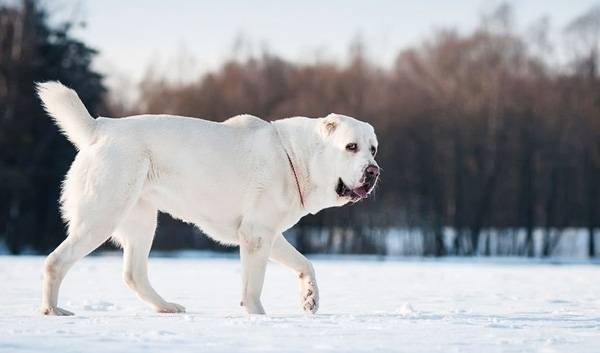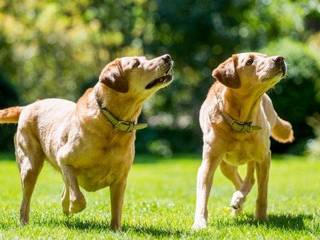In old told a very interesting legend about Adam. The legend was that when God expelled Adam from Paradise, and he stepped to the ground. The man was immediately surrounded by wild beasts and evil, which was the a-headed dog. Adam asked God for help in saving his life. God said that he was not afraid and stroked the dog's head. Soon the first man on earth God listened and did as he said. And when Adam stroked the dog, she immediately began to defend it. Therefore, they say that the dog - is the best defender and one man. Homeland Alabai - Turkmenistan. In this country, Alabai were separated from other animals. Alabai - this is the breed that no one was mixed, so the original form has been saved.
When people were tending their flocks, they used dogs to protect their populations, as the dogs were needed to fall cattle. Then life changed, and the dog was necessary only for defense and protection. Alabai was an assistant on guard duty. At that time there were many wild beasts, which could only protect this breed of dog. The main features of Alabai - its endurance and simplicity in food. Alabai is capable of a very long time to work, to protect the herd from predators, to feed him, and thus can not have the whole day. The dog is able to come to grips with the wolf. Alabai can have bad food and still be strong. Weather is no obstacle for the dog. Dog endures any changes. Alabai can live in very hot weather, and in very cold.
Another remarkable ability of Turkmen's dog is, that he is in the form of a snake as a threat to the host and rushes to help him. The dog cruelly breaks the snake's spine. To become a dog on - refers to another in the seventh century, when the Arabs conquered Central Asia. The Arabs had their own culture and their own faith. Fire-worshipers are considered sacred dogs, but Islam is considered unclean dogs. So soon the dog was no longer a man's best friend. Dogs were simply killed, leaving only the smallest and kind. Probably, therefore, the Turkmen Alabai does not show anger when he is on foreign soil, and the true and quietly carries its service protection. In Asia, there were numerous conquests and hiking. These were nomadic, cattle are grazed, and there was no longer do without a large dog that is able to protect. It was the careful selection of strong and courageous dogs and there is already selected the best that can survive in harsh conditions. And this was precisely the breed Alabai.
The view of the faithful and beloved friend is not changed and after five thousand years, though on their way met many difficulties that Alabai held alongside his master.
FAQ
Where do alabai dogs come from?
Alabai dogs, also known as Central Asian Shepherd Dogs or Central Asian Ovcharkas, originate from Central Asia, particularly in countries such as Turkmenistan, Uzbekistan, Kazakhstan, Tajikistan, and Kyrgyzstan. These ancient working dogs have been used for thousands of years by nomadic shepherds and herders to guard livestock and protect their families from predators, including wolves and bears.
Can Alabai kill a wolf?
Alabai dogs, or Central Asian Shepherd Dogs, have been bred for centuries to guard livestock and protect them from predators, including wolves. Their size, strength, and protective instincts give them the ability to deter or confront wolves if necessary. However, whether an Alabai can actually kill a wolf depends on various factors, such as the size and strength of both the dog and the wolf, their respective levels of aggression, and the specific circumstances of the encounter.
It's essential to remember that dog breeds like the Alabai have been developed to intimidate and deter predators rather than engage in direct combat. Their primary role is to act as a guardian and protector, driving away potential threats to their flock or family. While an Alabai dog might be able to defend against a wolf, it's not guaranteed that they could kill one, and such a confrontation could result in severe injuries or death for both animals.
Why is Alabai banned in Denmark?
Alabai dogs, or Central Asian Shepherd Dogs, are banned in Denmark due to their classification as a dangerous breed under Danish legislation. Denmark has strict regulations regarding dog breeds that are considered potentially dangerous, and these regulations aim to prevent incidents involving aggressive dogs and ensure public safety.
The list of banned breeds in Denmark is based on the perceived risk associated with the breed's size, strength, temperament, and history of aggressive behavior. Alabai dogs, along with several other breeds, are included on this list because they are large, powerful, and may exhibit protective instincts, which could pose a risk if not properly managed.
Are alabai dogs dangerous?
Alabai dogs, also known as Central Asian Shepherd Dogs or Central Asian Ovcharkas, are large and powerful working dogs originally bred for guarding livestock and property. Whether an Alabai dog is considered dangerous largely depends on the individual dog's temperament, upbringing, training, and socialization.
Inherently, Alabai dogs are not dangerous animals. They are known for their loyalty, protectiveness, and natural guarding instincts. However, due to their size, strength, and independent nature, they require experienced and knowledgeable owners who can provide proper socialization, consistent training, and strong leadership.
If raised and trained appropriately, Alabai dogs can be reliable and protective family pets. However, if they are not provided with proper socialization, training, and care, they can potentially become aggressive or unmanageable, which could lead to dangerous situations. As with any breed, responsible ownership and an understanding of the breed's specific needs are crucial to ensuring a well-behaved and balanced dog.






